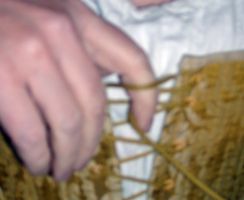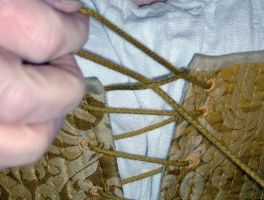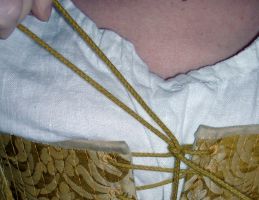| INDEX | 1300-1599 | 1600s | 1700s | 1800s | 1900s | CROSS-ERA | ETHNO | |
| MISCELLANY | CONTACT | SEARCH | |
|
|
Thread silk ribbon through the eyelets in the strap ends and front stumps so that you can tie them in a bow on the outside. Tighten or loosen the ribbon if necessary.
Always wear the stays on top of the shift, not on the skin: Stays are not easy to wash, especially if the boning is steel (rust!). And of course, it's not authentic not to wear a shift underneath.
Thread the lacing cord/ribbon through the lacing eyelets as shown in the sketch to the left: Attach one end to the first hole where they sit closer together. Various methods can be used, e.g. a knot large enough not to slip through the eyelet even under stress, or any kind of loop through the hole. Personally I prefer a bowline, a type of sailor's knot that results in a strong, secure loop.
Thread the other, longer end through the eyelets in a spiraling fashion as seen in the sketch, i.e. on one side you always go outwards, on the other side always inwards. Never have the cord cross from the outside to the inside or the other way round as you'd do with a shoe lace. From the outside, you only ever see parallel passes.
To facilitate threading, you can thread the ribbon through a large, blunt darning needle whenever you want to dress. Better yet, wrap the end tightly with sewing thread which you secure by going through the ribbon/cord a few times, and/or dip it into hot wax to achieve a stiff end resembling that of shoe laces.
For more thorough info on period lacing, see "The
Zen of Spiral Lacing".

When you've come to the last eyelet, insert a finger behind the last pass,
...
 ... hook the lace end and pull it through as if you were crocheting. Pull on
the loop to tighten it.
... hook the lace end and pull it through as if you were crocheting. Pull on
the loop to tighten it.
These pictures show a front lacing which is supposed to close edge-on-edge, while the back lacing is supposed to gap open a bit all down its length. So in case of front-and-back lacing, have the back one gap open but pull the front one closed. Since I can't count on having a helper available every time I dress or undress, my stays are front-and-back lacing ones. I closed the front lacing all the way, then had someone pull the back lacing as tight as it would go, and make a very secure knot. The back lacing is never touched: I always open and close the front lacing only. The back lacing is only there for authenticity and to adjust for weight loss or gain.
 Treat the loop as if it was one end of a shoe lace. Tie it to the cord end around
the last pass as if you were tying shoe laces. Make sure the tie doesn't slip.
Stuff the suplus cord into the top of the stays.
Treat the loop as if it was one end of a shoe lace. Tie it to the cord end around
the last pass as if you were tying shoe laces. Make sure the tie doesn't slip.
Stuff the suplus cord into the top of the stays.
Whether you thread the lacing top down or bottom up is a matter of taste. Traditionally it goes bottom up because it's easier to achieve a small waist and lifted bust that way, I'm told. But as nowadays most people don't have a servant handy whenever it may be necessary to unlace, I prefer top down for back-lacing stays. In case of an emergency or if everyone else is already fast asleep or too inebriated to deal with a tight knot, it's easier to open a knot at the small of one's own back than one between the shoulder blades. It's also easier to bind one if you have no help putting it on. However, if you can't count on help every time you dress/undress, you should opt for back-and-front lacing. The ease of dressing and undressing that way easily makes up for the hassle of making twice as many eyelets.
To put a back-lacing corset on by yourself, the technique is a bit like for a back-closing bra: Ignore the shoulder straps for the moment and put it on backwards. Thread the lace through the lacing holes, then turn the corset the right way round, slip on the shoulder straps and, reaching behind you, pull tight. If you can reach up your back (a mirror can help here), try to pull at each pass in turn instead of just pulling on the end of the lace. Keep the end of the lace taut while doing so. The more slippery the cord, the fewer steps you will need, but you will also have to hold on to it much tighter.
Before pulling the lace in earnest, straighten out the shift. Pull it down until the neckline sits about right, front and back. Raise your arms to make sure there's enough give. Contrary to what many a beginner fears, the shift folds will not chafe, however numerous or bulky they may be. They'll probably imprint on your skin, but like a fold in your pillow, you won't feel it.
If the corset fits correctly, you can lace it to fit quite snugly first, and give it another pull a while later when the feeling of being compressed wears off. It does! It's not just that you get used to it : The stays stretch a bit and the lacing may loosen slightly. You can go on pulling a bit more whenever you've started to feel comfortable. Period ladies would start lacing in the morning in order to achieve a small waist in time for an event in the evening. As long as you don't feel uncomfortable, it isn't too tight. Don't be afraid of damaging yourself as the bad press for corsets suggests: As long as you feel comfortable, you're OK.
Both well-endowed and poorly endowed ladies often have a problem achieving that desired "two apples on a tray" look: Either the "apples" slide down into the stays because there's too much room below, or they're pressed flat. Two causes, one solution: Make two small crescent-shaped pillows, stuff them not too tightly e.g. with un-spun cotton or wool, and fix them to the inside of the stays so that they push up your bosom.
If the fit is OK, you should be able to wear the stays for hours on end without any training. "Training" just means that you can lace more tightly when you're used to it, but even then you stop pulling the lace if it gets unfomfortable. If your stays start to hurt after a while, something is wrong - it either doesn't have the correct fit, or a bone or two in strategically important places have given. In the latter case, stronger boning (i.e. steel instead of plastic and/or additional boning) in that place should help. Don't clench your teeth to endure it – take the stays off and remodel them as soon as possible. In one of my corsets, e.g., a pair of bones had to take too much strain (I have a hollow back), gave and let the waistline dig into the flesh. The small of my back was sore for days after.
Let the stays air out ot for a while after wearing. With a shift underneath, the amount of sweat that gets through to the stays should be minimal, an even then proper airing should make it unnecessary to wash the stays. Nevertheless, after a few years or after a particularly hot summer, it may become necessary to clean the stays. Let's hope that neither the fabric nor the thread tends to bleed. Soak the stays in a lot of water, but don't use soap. Move them around a bit and take them out of the water after, say, 2-3 hours. Any sweat that may have soaked into the fabric should be gone by that time. Let them dry out flat, e.g. by placing them across multiple lines. I have washed my stays once so far, and although there's steel boning in it, I haven't seen any rust yet.
The best way to store the stays is rolled up, with the lace wrapped around the roll. This will also work towards straightening out bent boning.
Chapter 5: Fully-boned variety
Content, layout and images of this page
and any sub-page of the domains marquise.de, contouche.de, lumieres.de, manteau.de and costumebase.org are copyright (c) 1997-2022 by Alexa Bender. All rights reserved. See Copyright Page. GDPO
This work is licensed under a Creative Commons License.